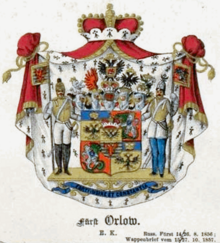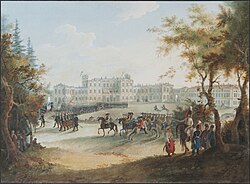Orlov family


The House of Orlov (Russian: Орлóв) is the name of a Russian noble family which produced several distinguished statesmen, scientists, diplomats, and soldiers. The family first gained distinction in the 18th century through the achievements of five Orlov brothers, of whom the second eldest was Catherine the Great's paramour, and two younger brothers were notable military commanders.
Orlov brothers
Grigory Grigoryevich Orlov
Count Grigory Grigoryevich Orlov (1734–1783), who created for his family such an illustrious Russian history, was the son of Gregory Orlov, governor of Great
After the event, Catherine raised him to the rank of count and made him adjutant-general, director-general of engineers and general-in-chief. Their illegitimate son, Aleksey, was born in 1762 and named after the village of

Gregory Orlov was no statesman, but he had a quick wit, a fairly accurate appreciation of current events, and was a useful and sympathetic counsellor during the earlier portion of Catherine's reign. He entered with enthusiasm, both from patriotic and from economical motives, into the question of the improvement of the condition of the serfs and their partial emancipation. As the President of the Free Economic Society, he was also their most prominent advocate in the great commission of 1767, though he aimed primarily at pleasing the empress, who affected great liberality in her earlier years.[1]
He was one of the earliest propagandists of the
In order to rekindle Catherine's affection, Grigory presented to her one of the greater diamonds of the world, known ever since as the
Alexei Grigoryevich Orlov
Count Alexei Grigoryevich Orlov (1737–1808), brother of the above, was by far the ablest member of the Orlov count family, and was also remarkable for his athletic strength and dexterity. In the palace revolution of 1762 he played an even more important part than his brother Gregory. It is alleged that he conveyed Peter III to the chateau of Ropsha and murdered him there with his own hands.[1][a]
In 1770 he was appointed commander-in-chief of the fleet sent against the Turks, whose far superior navy he annihilated
The same year, on Catherine's request, he went to
There he devoted himself to
Beside of animal breeding he also formed the first Roma-choir (1774), selected out of his numerous Roma serfs[b]. The choir reached an enormous popularity under the Russian aristocracy, and was copied by several other aristocrats training their Roma to sing in choirs. In 1807 the Orlov choir was given freedom. They could settle themselves in Moscow (which was forbidden to all other Roma) and lived and behaved as the aristocrats around them. Their offspring attended school and university and became the first Roma-intelligentsia. The Roma choirs influenced the image of the Roma in Russia a lot until at least the 20th century.[3]
The other Counts Orlov

The oldest and least notable of four Orlov brothers was Ivan Grigoryevich Orlov (1733–1791). After his father's death in 1746 he became the head of the family; all Orlov brothers looked upon him and respected him as their father. He led a modest life and managed the Orlovs' estates. Even after the palace revolution of 1762, when the Orlovs became counts and got enormous fortune, he apparently refused any state career and titles and continued to live in Moscow and the Orlovs' estates.
The fourth Orlov brother was Count Fyodor Grigoryevich (1741–1796), Russian general, who first distinguished himself in the

The youngest Orlov brother was Count Vladimir Grigorievich (1743–1831). He was just 19 when his elder brothers came to power, and they deemed it wise to send him to the
He had several daughters, one of them a wife of Nikita Petrovich Panin, and a son - Count Grigory Vladimirovich (1777 – 22 June 1826) - who predeceased his father. Like him, Grigory the Younger devoted himself to the sciences. In November 1799 he married Countess Anna Saltykova, left Russia and traveled in France, Italy and Switzerland. While living in Paris, Orlov translated into French some fables by Ivan Krylov. After the death of his wife, Count Orlov returned to Russia. His chief works are Mémoirs historiques, politiques et littéraires sur le Royaume de Naples, translated into German, English and Italian, and embracing the History of Lower Italy from the earliest times until 1820; Histoire des Arts en Italie, the two volumes of which treat of music, the others of painting; Voyages dans une Partie de la France, ou Lettres descriptives et historiques (Paris, 1824). From 25 January 1809 he was an honorary member of the Russian Academy of Sciences. All of his three sons were born out of wedlock.
Princes Orlov
Alexey Fyodorovich Orlov

Prince
In 1854 he was sent to
Other Princes Orlov

Alexey Fyodorovich Orlov's only son, Prince
Prince Alexey Fyodorovich also had a brother, Mikhail Fyodorovich Orlov (1788–1842), who took a most active part in the Napoleonic wars and received the rank of General-major upon returning to Russia in 1814. A friend of
Prince
See also
- Fedor Polikarpov-Orlov
- The Orlov Diamond
- Orlov trotter
- Orlov Revolt
- Veal Orloff
- John Orloff
- Marble Palace
- Gatchina Palace
- Aleksandr Orlov
Notes
- ^ However, this is only conjecture, though Orlov's involvement is often cited and widely believed. It's believed that Catherine made sure she was nowhere near and claimed not to know of the murder until it was accomplished; sometimes it is said, against her will.
- ^ They were Xeladitka also called Russka Rom, not as sometimes thought imported slaves from Moldavië (Vlach) or from Oekraine (Servi-Rom)
References
- Palmer, Elena. Peter III - Der Prinz von Holstein. Sutton Publishing, Germany 2005 ISBN 978-3-89702-788-6
- This article incorporates text from a publication now in the public domain: Bain, Robert Nisbet (1911). "Orlov". In Chisholm, Hugh (ed.). Encyclopædia Britannica. Vol. 20 (11th ed.). Cambridge University Press. p. 293.
